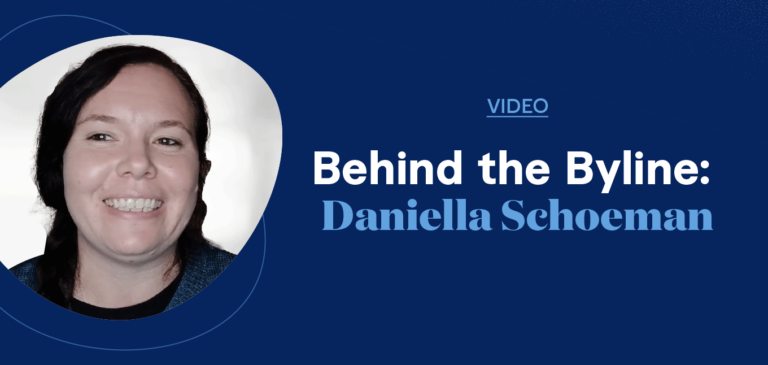One crucial thing must happen before your audience buys your products or services — brand awareness. No one can buy from your company if they don’t know you exist.
Content is the key to ushering in awareness. The more content you create, the more people become aware of your brand (if your content is high-quality and relevant). Once that door opens, the world becomes your oyster.
Let’s explore the value of content in your business marketing strategy. We’ll cover why it’s a great marketing investment, the dangers of quitting early, and the anatomy of high-value content.
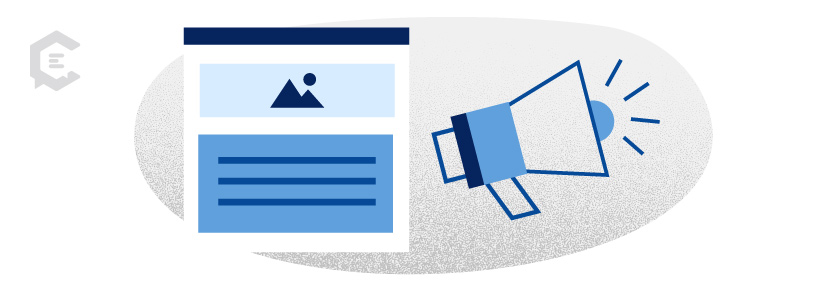
Value of Content in Marketing: Why is it Important?
Let’s approach the question, “Why is content important?” from an SEO perspective first.
With carefully researched, crafted, and search-engine-optimized content, your content pieces have a higher tendency to rank on the search engine results pages (SERPs).
As your pages rank, your marketing campaigns will yield these meaningful results:
- Organic, long-term, relevant traffic
- Recurring leads and sales
- Your brand visibility shoots up
- Your brand credibility skyrockets
Now imagine sleeping soundly at night, waking up in the morning, and seeing thousands of visitors (from search engines) landing on your site and buying your products without you spending a single cent on paid ads.
You can accomplish all that if high-quality content is at the core of your marketing strategies.
If not from an SEO standpoint, here are other ways to see the value of content:
- Cut costs. Create an FAQ page for your customers so you can address their concerns without hiring hundreds of customer support agents.
- Build meaningful relationships with your audience. Send email newsletters containing tips and strategies that address their most glaring problems. This increases their level of trust in your company.
- Improve your conversion rates. By incorporating copywriting principles, your content’s ability to influence readers to take action on your offers drastically increases.
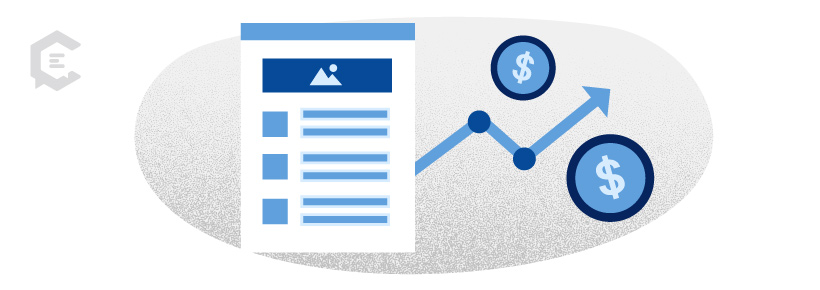
How a Great Content Strategy Can Make You Money
A solid content strategy is a great marketing investment. Why? Well, it helps you make money in two ways:
- It increases your sales. It allows you to create highly relevant and value-packed content. A content that can WOW your audience into trusting your brand, subscribing to your email lists, ranking your pages on the SERPs, and following your social media pages. All this puts you in a far better position to sell your services and products down the line.
- It optimizes your marketing spend and cuts costs. Which then increases your profit. Some companies spend thousands of dollars creating truckloads of content that they think their audience will appreciate and read. All to find out their hunch is misguided, as evidenced by their audience ignoring their content.
You can avoid spending on needless content with a sound content strategy since developing one requires in-depth research. Through research, you uncover your audience’s needs and wants. Then, you can use that research to build your audience through content.
A carefully crafted marketing strategy isn’t based on a hunch or gut feel. Its foundation is a careful analysis of hard, cold data.
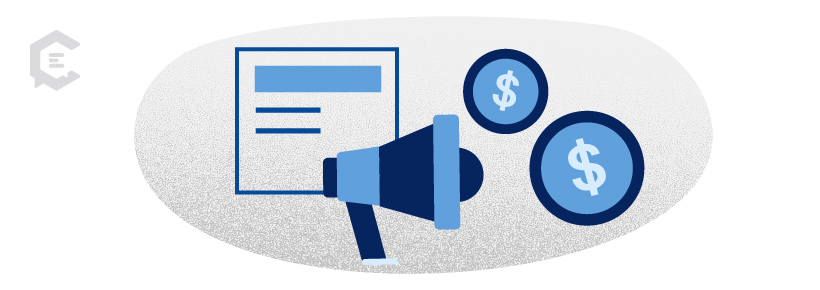
Cost of Content Marketing
Regarding costing, agencies and consultants will show you a ballpark figure of anywhere from $2,000 to over $50,000 per month. The actual figure depends on several factors, like your marketing goals, industry, existing content library, etc.
Why is content marketing so pricey?
- Content research and optimization: Content research and SEO professionals may charge a flat fee of $50-$200 per hour. However, research and optimization are usually bundled with a content development package.
- Content development: The cost of content development, including content writing, design, and editing, is between $200 and $3,000 per content piece. The higher end of this price range may include add-ons like custom visuals, social media captions, formatting, translations, and more.
- Content promotions: The cost of content promotion campaigns varies greatly based on the channels you use. For example, a Facebook ad campaign may cost around $1 per click or $12 per 1,000 impressions (ad views). In contrast, organic strategies like social media posting and guest blogging may cost upward of $100 per post.
In most campaigns, the volume of content produced, published, and promoted is the biggest cost-affecting factor.
The length of each piece also affects the overall cost of content marketing. If you want to manage your expenses and maximize ROI, be sure you understand the differences between short-form vs. long-form content. Also, don’t forget about temporary vs. permanent content either. Each has its unique utility, and you’ll most likely have to incorporate both types into your strategy.
Why use content marketing?
Content marketing services may be pricey, but the benefits far outweigh the costs.
Successful content marketing elevates your brand’s image, generates demand for your products or services, and brings more traffic to your virtual storefront. It can also improve sales performance by pulling in high-quality leads and nurturing them with useful and compelling pieces of content.
As an inbound strategy, you don’t need to constantly launch promotion campaigns to reap the benefits of content marketing, especially if you hit your SEO goals.
Once you reach Google’s first page, your website will steadily generate free organic traffic. You just need to conduct routine SEO maintenance, which only costs a fraction of the price of full-on content marketing.

The Dangers of Quitting Content Marketing Too Early
Content marketing isn’t a weekend project. You either commit to content marketing for the long haul or don’t expect meaningful results altogether.
According to Spyralitics, it takes 3-6 months for any piece of content to reach Google’s first page. And most websites don’t achieve that in the first year.
It pays to be patient
If you pull the plug on your content marketing too early, users will think you’re no longer operating. This forces them to turn to your competitors for the content they need and never look back.
Optimizing a content strategy takes hundreds of hours of vigilant monitoring. To identify what content types, topics, and distribution methods get the most results, use tools like Google Analytics, Semrush, and Ahrefs. They’ll help you track metrics that gauge your content’s performance over time, like traffic, conversion rate, backlinks, and keyword rankings.
Just remember: it takes time to gather enough data to provide actionable insights.
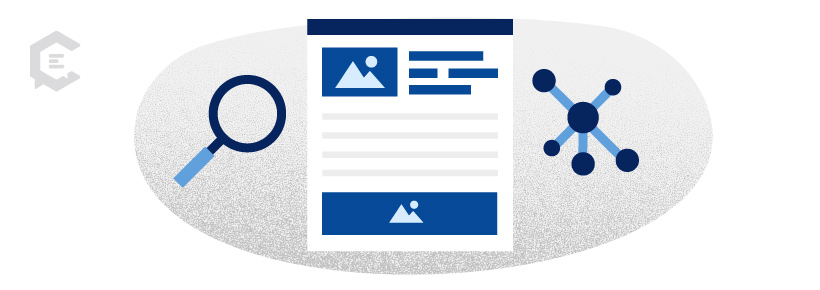
Anatomy of High-Value Content
You must consistently produce top-quality, high-value content to get noticeable content marketing results. Study the anatomy of high-value content below to learn how to create winning pieces every time.
1. In-demand content idea
Every guide to content creation on the internet starts with content ideation. This refers to the process of researching and choosing topics for marketing content.
Without content ideation, you could waste resources on pieces no one will read. And even if poorly-researched content does manage to get traffic, chances are they won’t result in conversions.
2. Clear and click-worthy headline (H1)
Content ideas are useless if they’re not refined into clear, attention-grabbing headlines.
A headline or content title is the first thing users see when coming across your content. It needs to let readers know what they’ll gain from your content and incorporate wordsmithery to compel them to click.
Note that headlines double as clickable links on search engine results pages (SERPs).
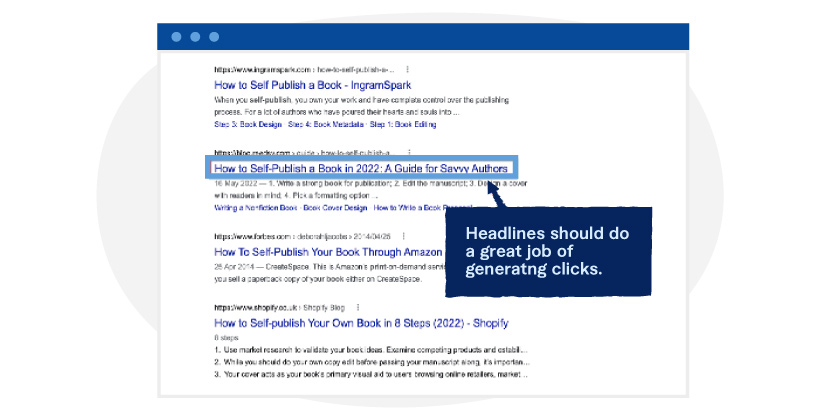 Source: Google.com
Source: Google.com
Headlines use the HTML tag H1. Their format depends on the content type, which leads to the next element of winning content.
3. A well-defined article structure
Is your content meant to help readers learn a skill? Or are they created to help them choose between multiple products?
This is where website content structures step in. Content structures or outlines give readers a sense of direction. Some examples are:
- Listicles: These articles are built around a list of things, be it tools, strategies, best practices, mistakes, and so on. They’re easy to create and even easier to digest for your audience.
- How-to guides: A how-to guide is the perfect content structure if you want to help readers learn a skill or solve a problem. Guides also help brands underline their expertise and build their authority.
- Reviews: Product or service reviews help readers decide whether or not something is worth their money. Bloggers and online publications typically review affiliate products, earning them commissions for completed sales.
- Comparisons: Comparison posts not only review multiple products — they pit them against each other and pick a clear winner. Businesses can use comparison posts to highlight the advantages of their products over alternatives.
- Ultimate guides: Ultimate guides can combine any of the article structures above. Their goal is to help readers learn as much as possible about a topic and compel them to take action — usually by encouraging them to buy something.
Aside from the structures above, you can use dozens of other content types for specific marketing goals. It’s a wise choice if you want to make the most out of your content.
4. Informative visuals
Decorative graphics and context-less stock photos are useless in an article. Informative visuals, however, enhance the reading experience and lift the overall value of your content.
For example, annotated screenshots effectively teach readers how to use a software product. Whereas infographics or data visualizations present data and complex information in a more readable fashion.
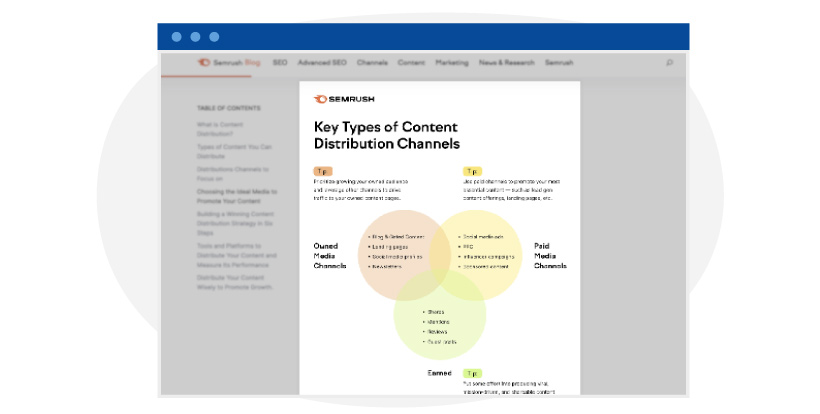 Source: Semrush.com
Source: Semrush.com
5. Subheadings (H2, H3, H4, etc.)
Subheadings help readers scan your content for the information they need. They also help content writers turn broad topics into bite-sized pieces for their readers.
Various subheading tags can be used to establish a hierarchy in your content.
6. Links
There are two types of links you can insert into your content: external links and internal links.
External links point to another website, while internal links point to a different page on the same website. Both types of links are valuable for SEO and the user experience.
For one, external links enable readers to validate your claims. Showing that your content is based on concrete data makes your piece more authoritative and compelling. On the other hand, internal links allow users to find supplementary information about the topic they’re reading about.
They also spread “link equity” by helping search engine bots or “crawlers” index your inner pages.
7. Well-written body
The body is one of the most important parts of a high-performing content piece. It’s where all the good stuff is, including tips, stats, strategies, tools, step-by-step instructions, etc.
Proper formatting and spacing are essential to improve the readability of the content’s main body. Instead of writing thick walls of text, writers need to utilize formatting options like numbered lists and bullet points. They also need to keep sentences and paragraphs short and concise.
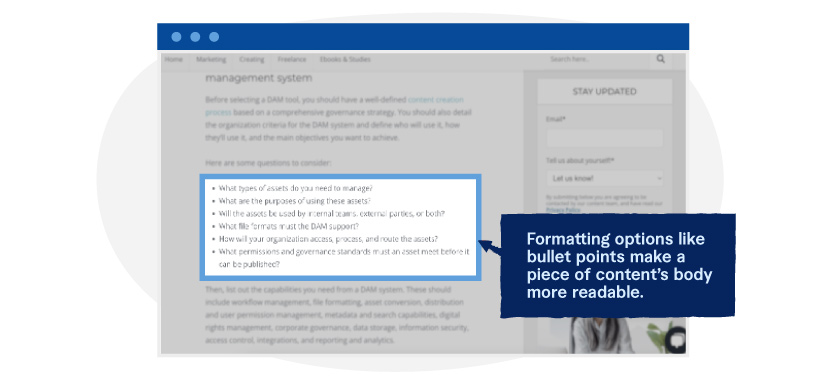
8. Convincing call-to-action (CTA)
Every solid piece of content has a call-to-action (CTA) that compels readers to take the next step.
CTAs are tailor-made to your marketing goals. They can encourage readers to subscribe to your mailing list, make a purchase, click a link, or whatever conversion goal you have in mind.
Present CTAs as clickable links, buttons, or graphics. Doing so makes them stick out from the rest of your content and generates more clicks. And make sure you have a strong CTA strategy in place.
9. Solid promotion strategy
Content promotion is just as important as content creation.
While great content ranks and attracts traffic over time, promotion techniques get the ball rolling. This includes sharing posts on social media, Q&A websites, guest posts, and content syndication platforms.
Bonus: Making it personal
When you’re creating your content, broad messaging isn’t going to get the job done. You need to have a strong content personalization strategy to ensure your content speaks to your audience’s unique needs and pain points. That will be the key to attracting and forging an emotional connection with your customers.
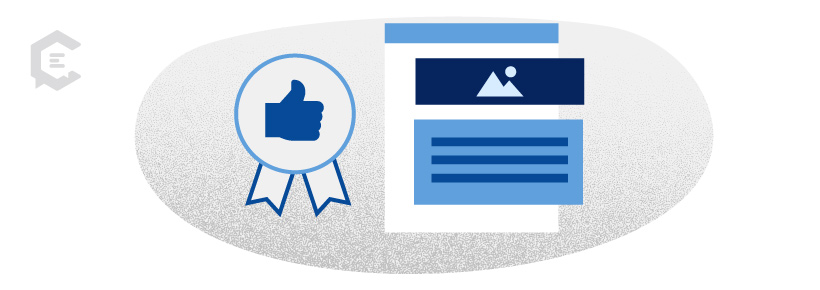
Steps to Create a High-Performing Content Strategy
Now that you understand the anatomy of winning content, put this information to use with these steps:
1. Begin with content ideation
Use content ideation strategies to develop a list of topics to write about.
Not sure what to ideate? Map out your content strategy goals.
Once those are in place, keyword research is the first technique you should try. This will provide you with content ideas and target SEO keywords. Semrush’s Keyword Magic Tool is great for this. Plug in any broad keyword or topic and click ‘Search’ to start.
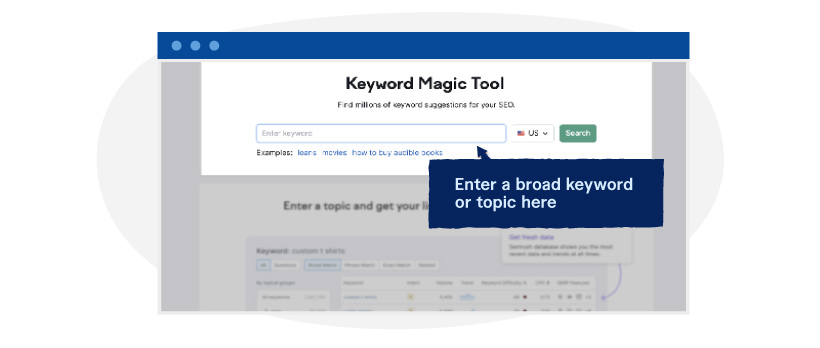
Source: Semrush.com
To find potential content ideas, scan the keyword list for informational, transactional, and commercial keywords. Look under the “Intent” column to identify these keywords.
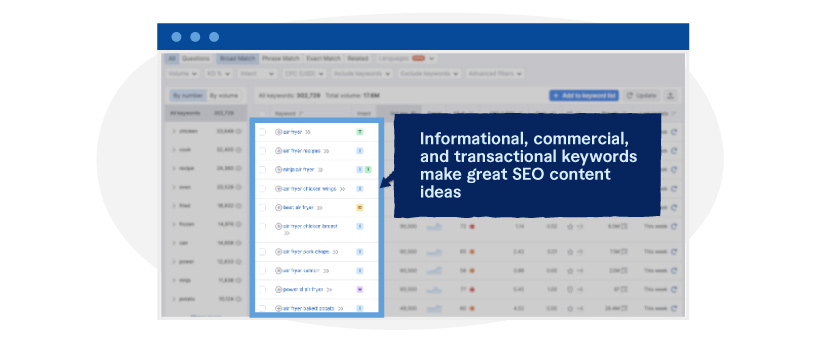 Source: Semrush.com
Source: Semrush.com
Below are a few content ideation tips that will help you find more content topics:
- Check question-based keywords to understand the problems your target audience has
- Use other topic research tools like AnswerThePublic for more ideas
- Analyze keyword metrics (volume, difficulty, and PPC) to gauge the profitability of each keyword
2. Build a topic cluster
Keep using content ideation techniques until you have enough ideas for a topic cluster.
A topic cluster is a network of interlinked content about related subtopics. The main topic will be covered in a “pillar page,” which links to all posts within the cluster.
Work on the pillar page first when creating topic clusters. For the cluster posts, prioritize subtopics that impact your reader’s goals most.
3. Create click-worthy titles
Write short, keyword-optimized, and compelling titles to capture your target audience’s attention. During the content development stage, it’s normal to have three or more title variations your team can choose from before publishing.
Put the keyword near the beginning or the end of the headline. This helps with your content’s rankings and informs readers what your content is about from the get-go. As for the headline’s length, shorter keywords generally rank higher in SERPs. However, writing concise headlines is not a rule set in stone.
Review the top ten search results to estimate the ideal title length for your content. You may also borrow ideas on structuring your headline and which words to include.
4. Create a detailed outline
A detailed outline includes a headline, target word count, keywords list, and subheadings. Successful content marketers go the extra mile and list external links to resources and internal links to related posts.
Remember these tips when constructing your content outlines:
- Add links to posts you want to model your content after. This will help writers understand the quality and value you expect from them.
- Highlight your focus keywords. Include a list of the “must-have” keywords and instruct writers to mention them near the beginning of your post.
- Include “Frequently Asked Questions.” Check SERPs for “people also ask” questions and include them in your outline.
- Target the average content length of the top 10 results. For higher rankings, aim to match or exceed this average.
- Identify key takeaways. Define what the content should help readers accomplish.
5. Include all the elements of high-value content
Don’t approve posts unless they have all the elements of winning content. This includes internal links, external links to authoritative sources, informative images, and CTAs.
If you work with a team of writers, create a content brief template that mentions these requirements.
Remember that every element should align with the takeaways of the piece. If something doesn’t help readers accomplish their goals, delete it — it’s fluff.
6. Refine your copy
Always proofread and edit posts before you publish or schedule them.
Elaborate content marketing teams do multiple rounds of edits through an editorial team to ensure quality. To streamline this process, consider automated proofreading tools like Grammarly and ProWritingAid.
Both tools automatically detect a draft’s grammatical, spelling, and readability issues. They also provide correction suggestions that can be applied in an instant.
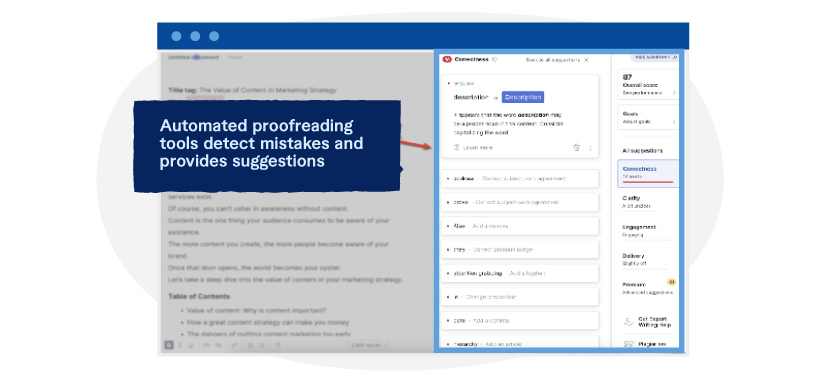 Source: Grammarly.com
Source: Grammarly.com
7. Squeeze evergreen value out of content
Don’t delete old posts just because they failed to meet your expectations. Rather repurpose them.
Repurposing involves taking old content and re-packaging it into a different format. For example, a listicle of statistics can be turned into an infographic and shared on channels like Pinterest and Instagram. If the post can be salvaged, refresh the content to give them another shot at getting traffic. Here are some tips for refreshing content.
Bonus: Encourage a collaborative approach
In content strategy, content can operate in silos that are confined to specific departments and roles. Sometimes that’s necessary, but make sure content silos aren’t hindering you from delivering a cohesive, consistent experience to your audience. One of the foundations of any strong content strategy is communication. The less communication, the harder it is to execute a unified content vision.
What to Look Out for in Content Strategy Services
Building a content strategy is exhausting, which is why many businesses outsource content strategy services. If you wish to follow suit, look for the following:
- Intuitive contact option. Can you schedule a discovery call? What questions do they ask in their contact form?
- A diverse pool of talent. Do they have specialists in blog posts, white papers, eBooks, presentations, and other SEO content types?
- Flexible pricing. Do they offer services as a package or tailor plans to your specific needs?
- Verifiable proof of results. Can they show results with successful clients in the past?
- Transparent process. Are they willing to discuss their content strategy and marketing processes? Do they provide open communication channels during campaigns?
3 Content Marketing Strategy Examples
Mold your strategy according to these brilliant content marketing strategy examples:
1. MarketingProfs Learning Paths
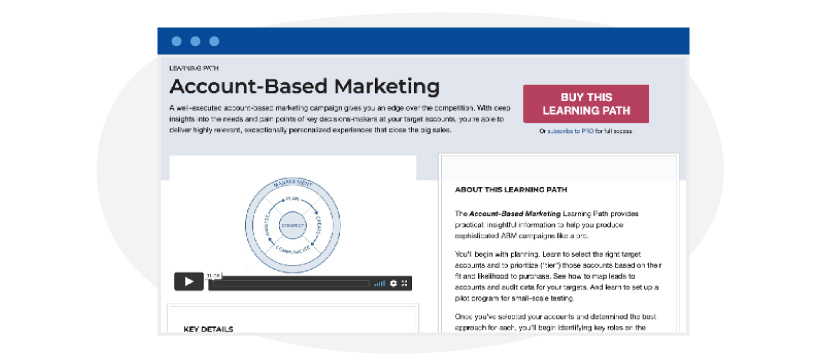 Source: MarketingProfs.com
Source: MarketingProfs.com
MarketingProfs Learning Paths are gated content groups that consist of online training courses. These exhaustively cover everything you need to know to manage your marketing campaigns.
2. Semrush Blog
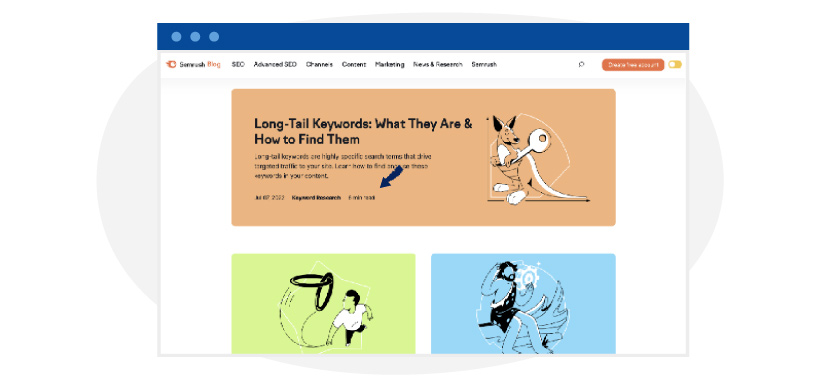 Source: Semrush.com
Source: Semrush.com
The Semrush blog is a haven for professional marketers, agencies, and businesses. In addition to visual-heavy blog posts, the blog also offers free online courses and webinars.
3. Content Marketing Institute Annual Reports
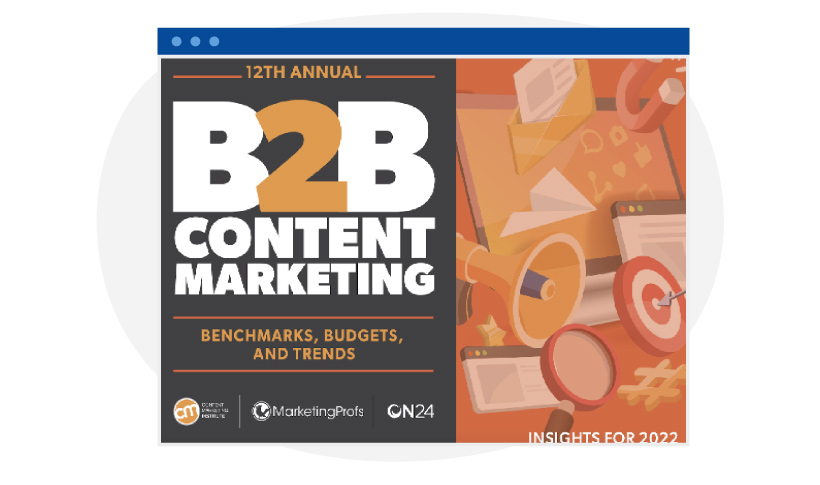 Source: ContentMarketingInstitute.com
Source: ContentMarketingInstitute.com
The digital marketing community considers Content Marketing Institute’s annual marketing reports the industry standard. Each year, they compile a massive list of statistics and outlooks on the content marketing landscape.

Content Marketing FAQs
1. What is the value of content marketing?
The value of content marketing comes from the resulting action readers take after consuming your content. They may subscribe to your email list, buy something from you, share your content, follow you on social media, or do any other action that adds to your marketing goals.
2. What are the benefits of content marketing?
Content marketing is the key to sustainability for any online business. It provides websites with long-term, high-quality traffic from organic sources, like social media, search engines, and referring domains.
3. What does content value mean?
Brands measure content value based on their marketing goals and Key Performance Indicators (KPIs). Others use a content scoring system, which measures the effectiveness of content in converting users through every stage of the marketing funnel.
4. What is the purpose of content marketing strategy?
A content marketing strategy is designed to provide a content marketing team with long-term direction. It ensures every step in the content research, development, tracking, and optimization processes aligns with the brand’s goals.
5. Why is content so important?
Content is the primary commodity on the internet that attracts, engages, and converts online users. Every campaign — inbound or outbound — is fueled by high-quality content, like advertising copy, blog posts, downloadables, and online video courses.
Get All the Value Out of Your Content
Investing in a carefully crafted content marketing strategy helps you get more mileage from your content marketing initiatives. It secures the sustainable and exponential growth of your brand online.
Sadly, not everyone has the time to learn the skills of a content marketing mastermind. Focus on what you do best, and let us handle the content marketing side of your business.
Speak with one of our content experts, and let’s formulate a content creation plan and strategy that works for you.



